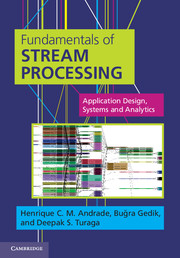Book contents
- Frontmatter
- Dedication
- Contents
- Preface
- Foreword
- Acknowledgements
- List of acronyms
- Part 1 Fundamentals
- 1 What brought us here?
- 2 Introduction to stream processing
- Part II Application development
- Part III System architecture
- Part IV Application design and analytics
- Part V Case studies
- Part VI Closing notes
- Keywords and identifiers index
- Index
- References
2 - Introduction to stream processing
from Part 1 - Fundamentals
Published online by Cambridge University Press: 05 March 2014
- Frontmatter
- Dedication
- Contents
- Preface
- Foreword
- Acknowledgements
- List of acronyms
- Part 1 Fundamentals
- 1 What brought us here?
- 2 Introduction to stream processing
- Part II Application development
- Part III System architecture
- Part IV Application design and analytics
- Part V Case studies
- Part VI Closing notes
- Keywords and identifiers index
- Index
- References
Summary
Overview
Stream processing has been a very active and diverse area of research, commercial, and open-source development. This diversity of technologies has brought along new terminology, concepts, and infrastructure necessary for designing and implementing sophisticated applications.
We start this chapter by describing some of the application domains where stream processing technologies have been successfully employed (Section 2.2), focusing on the distinctive characteristics of these applications that make them suitable for the use of stream processing technologies.
These application scenarios allow us to illustrate the motivating requirements that led to the development of multiple information flow processing systems, a class that groups multiple technical approaches to continuous data processing (Section 2.3). We discuss some of its broad subcategories, including active databases, Continuous Query (CQ) systems, publish–subscribe systems, and Complex Event Processing (CEP) systems. All of them are precursors that have helped shape the stream processing paradigm.
We then switch the focus to the conceptual foundations and the architectural support behind the stream processing technology, and the applications it supports (Section 2.4). We also include an overview of analytics, i.e., the algorithms and knowledge discovery techniques, that form the basis of most innovative Stream Processing Applications (SPAs) and a historical perspective on the research that led to the development of several Stream Processing Systems (SPSs).
Finally we include a survey of academic, open-source, and commercially available SPS implementations, and describe their different characteristics.
- Type
- Chapter
- Information
- Fundamentals of Stream ProcessingApplication Design, Systems, and Analytics, pp. 33 - 74Publisher: Cambridge University PressPrint publication year: 2014



